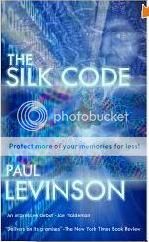
There are a number of FIRSTS associated with this book. This was the author's (Paul Levinson) first Published Novel. This was my first e-Book read on my new NOOK Reader. This was also the author's preferred edition of his work (which as always I assume to mean has been reworked sort of like a "Director's Cut" for a book)....It also marked the first appearance of forensics detective Dr. Phil D'Amato in "novel" form (he had appeared in the author's short stories).
So, with all that in mind and out of the way, let's lay out some background info. But before we do, it's important to understand what kind of book this is. "The Silk Code" is a Science Fiction novel with elements of a Scientific Mystery and a Detective Story. If your science fiction tastes run in the Space Opera category then this book is not for you. But you can look at it another way: Science Fiction does not only encompass classic Space Opera, Star Trek and Star Wars or Space Battles and Aliens; sometimes the Aliens are us, and the scientific discoveries are next door to us OR even in our own back-yard, here on planet Earth, the place we call home. And in the best, good Science Fiction, the Science part is just as important as the Fiction and you learn something from both, because in that story, and in its telling, you learn something about "yourself" and about what makes you human.
The story in this Novel centers around Phil D'Amato, a forensics doctor/detective for the NYPD, sort of a cross between a medical examiner and a guy who gets out on the street to look for answers about the bodies that cross his lab table at the examiner's office. It all starts innocently enough when Phil and a friend are visiting the Amish people in Amish country in rural Pennsylvania at the request of his friend. His friend has something to show him. {Ed: If you, dear reader, haven't gone to Amish country, you owe yourself the trip. Getting back to the review then.} But for Phil and his friend, the trip is a little more than he bargained for, as he uncovers a shocking secret that the Amish have kept for hundreds of years, if not thousands. As one Amish Leader essentially tells Phil, not all human technology has to be of the shiny, mechanical variety. And some things (and people) are more advanced than we expect. Some technology is biological. The answer may lie within our own DNA. But who or what holds the key to that answer?
Paul Levinson spins a masterful yarn that spans over 1300 years from 750 AD to the present and it involves the Amish, the Tocharians and the Neanderthals. This book was written at the close of the last century, and even with this revised edition, there are some things that will trip you up. For example, cell phone usage is not what you read or see in fiction today. On the other hand this novel (as all good science fiction novels should) was completely prophetic in acknowledging that we know nothing about the Neanderthals and they were not in fact the brutes that they have been portrayed in recent scientific literature (last 100 years or so). They were in fact more like us: they were artists, and singers, and fathers and mothers, and THEY survive in us today. There are people walking among us today carrying up to 4% or more of Neanderthal DNA.
Taking all these elements and spinning a tale out of them would be a feat for any writer. Building a tale and a world that is both believable, accessible to the casual reader -- and with that, I mean someone without a PhD in Biology -- can only be described as a major victory for a first Novel. This novel achieves what it sets out to do. It solves the two main mysteries at its core. It answers some major questions that are revealed along the way. It has a solid and believable cast. It is very entertaining and for me the right blend of suspense and exposition. Finally, it has an underlying mystery with enough unanswered questions left in the back of your mind, and Phil D'Amato's mind not to make you feel cheated, or to make you think that there is a sequel coming, but rather, to make you THINK. All great books achieve this symmetry. If all your questions were answered by great literature, would you continue to read after the first book, the second, the third? At what point would you stop? This book does this exceptionally well, and for this alone I would have recommended it. This is one of the best books I read in the last year and one of the best science fiction novels of all time, especially because of how it has predicted the last 10 years or so of Neanderthal discoveries. And Phil D'Amato is my kind of detective. Just the right blend of smarts and macho. Taken as a whole? I give this five stars -- easily.

No comments:
Post a Comment